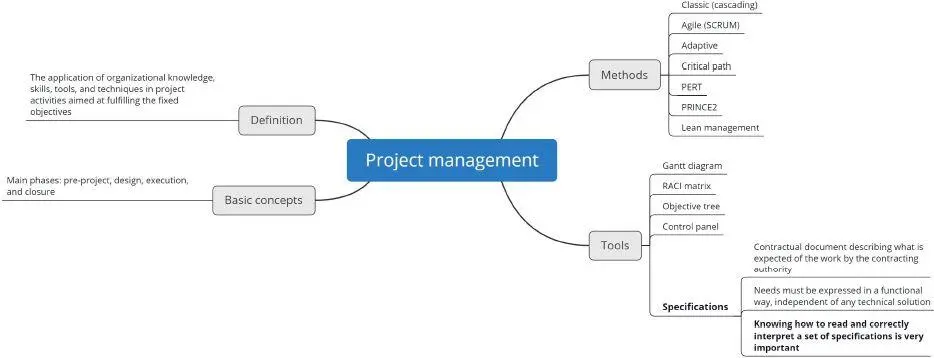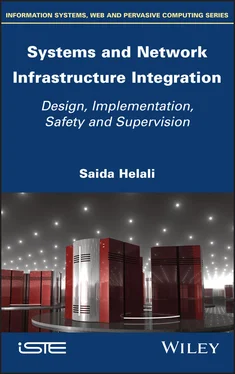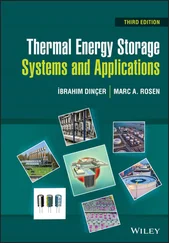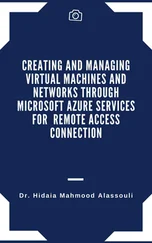Saida Helali - Systems and Network Infrastructure Integration
Здесь есть возможность читать онлайн «Saida Helali - Systems and Network Infrastructure Integration» — ознакомительный отрывок электронной книги совершенно бесплатно, а после прочтения отрывка купить полную версию. В некоторых случаях можно слушать аудио, скачать через торрент в формате fb2 и присутствует краткое содержание. Жанр: unrecognised, на английском языке. Описание произведения, (предисловие) а так же отзывы посетителей доступны на портале библиотеки ЛибКат.
- Название:Systems and Network Infrastructure Integration
- Автор:
- Жанр:
- Год:неизвестен
- ISBN:нет данных
- Рейтинг книги:5 / 5. Голосов: 1
-
Избранное:Добавить в избранное
- Отзывы:
-
Ваша оценка:
- 100
- 1
- 2
- 3
- 4
- 5
Systems and Network Infrastructure Integration: краткое содержание, описание и аннотация
Предлагаем к чтению аннотацию, описание, краткое содержание или предисловие (зависит от того, что написал сам автор книги «Systems and Network Infrastructure Integration»). Если вы не нашли необходимую информацию о книге — напишите в комментариях, мы постараемся отыскать её.
Systems and Network Infrastructure Integration — читать онлайн ознакомительный отрывок
Ниже представлен текст книги, разбитый по страницам. Система сохранения места последней прочитанной страницы, позволяет с удобством читать онлайн бесплатно книгу «Systems and Network Infrastructure Integration», без необходимости каждый раз заново искать на чём Вы остановились. Поставьте закладку, и сможете в любой момент перейти на страницу, на которой закончили чтение.
Интервал:
Закладка:
Table 1.1 recaps the main tools available for each phase of a project.
Table 1.1 Main tools for project management
| Initiation (pre-project) | Design | Execution | Closure | |
| Examples of tools | Objective treeRACI matrixSpecifications | ParetoWBSGantt diagramCommunication planRisk management | Collaborative work toolsBrainstormingProblem-solving toolsControl panel | Project review |
1.3.1. Gantt diagram
This is an effective and practical tool for project management created by Henry Gantt in 1917, which remains the most widely used representation tool. It consists of a graphic diagram useful for project planning and gives information and time frames for a project's phases, activities, tasks and resources.
Tasks are put in rows and durations (days, weeks or months) in columns. They are represented by bars whose length is proportional to the estimated duration. These can take place sequentially or partially or entirely simultaneously.
1.3.2. RACI (Responsible, Accountable, Consulted, Informed) matrix
The success of a project relies on the clear and precise definition of the roles and responsibilities of each actor involved. To do this, a RACI matrix is used. In this matrix, activities are laid out in rows and roles in columns. In each cell of the table, the role's responsibility for the activity is indicated, using the letters R, A, C or I.
Table 1.2. Example of a RACI matrix
| Role 1 | Role 2 | ... | Role m | |
| Activity 1 | R | A | I | C |
| Activity 2 | I | R | I | A |
| ... | A | R | C | I |
| Activity n | C | R | C | I |
It can be used to set out responsibilities in a project or within a company or business.
1.3.3. The concept of specifications
This is a contractual document describing what is expected from the project manager by the contracting authority. It is generally developed by the client and contains the following main sections: context, objectives, vocabulary or terminology, scope, schedule, etc.
The contracting authority is the party responsible for the expression of needs; they are the entity that places the order. The project manager is responsible for making these needs a reality.
The specifications must set out needs in a functional manner, independent of any technical solution with the exception of specifying the technical environment into which the solution requested must be inserted.
According to norm NF X 50-150 developed by the AFNOR, a functional specification document (FSD) is the document by means of which the requesting party expresses its needs in terms of service features and limitations. For each function and limitation, assessment criteria and their levels are defined.
NOTE.– The FSD is concerned with the service features of a product and their corresponding limitations, and does not contain any technical ideas or impose any solutions. Its objective is to propose the product best suited to provide the service(s) requested under the conditions specified and at minimal cost.
Knowing how to read and correctly interpret a set of specifications is very important for the success of the associated project. The project team must analyze needs, including understanding the expectations of the final users (the WHAT), and know how to put them into practice (the HOW). The team must gain a perfect understanding of the associated issue by asking itself the following questions:
– Who is requesting this solution?
– Who will use the proposed solution? With what benefits?
– What will be the solution's environment?
– What are the limitations and problems that may be encountered?
The ultimate goal always remains the satisfaction of the end-users' and clients' needs. These needs can be explicit or clearly stated, implicit or unstated but necessary. In this context, we can speak about functional specifications, pertaining to the functionalities expected of the project, and non-functional specifications, which represent the secondary characteristics to be offered.
Interpreting a set of specifications consists of:
– describing the project, including the context of work, motivations and objectives that will be evaluated at the end of the project, the challenges or difficulties to be overcome, and the criteria for success, or how to evaluate the project in relation to objectives;
– subsequently defining the phases of implementation of the project and the links between these phases using a Gantt diagram, for example. In addition, milestone targets and deliverables corresponding to each phase must be set, and a clear idea of the procedures has to be followed for the management and follow-up of the project.
1.4. Chapter summary

Note
1 This chart is also available at www.iste.co.uk/helali/systems.zip
2
Simulating Network Architectures with GNS3
“Problems in school are like problems in life, but without their consequences.”
Olivier Reboul
– Understanding the concept of simulation and its main theoretical aspects, as well as its capabilities and limitations.
– Understanding the main network simulation tools.
– Understanding how to use the GNS3 supervision tool and its features to model a network infrastructure based on specific needs.
2.1. Introduction
As with the development of applications, system and network infrastructures, even simple ones, must be tested before they are put into production. This good practice is vital to avoid numerous errors during the production phase.
Simulating and testing network infrastructure projects before deploying them concretely saves time and money, and ensures that they will function properly. A network simulator is a software program, free or paid, which is used to create virtual representations of IT networks.
2.2. Definition
According to Wikipedia, network simulation is a technique by which a software program (simulator) models the behavior of a network, either using mathematical formulas to calculate the interaction between the parts of the network, or by recording and reproducing observations made of a real network.
Simulation is a fictional representation of reality. It means to imitate a situation. The best-known example is probably that of flight simulators, which enable pilots to train without risk.
In the context of networks, simulation refers to the reproduction of the architecture of a network without using any physical equipment. The interest of the simulation lies in its ability to test the features and operation of a network architecture at no cost and without hindering the normal operation of the production network.
To do this, the simulation uses a software program that calculates (we will also use the term “modeling” to refer to this process) and thus predicts the events that will be led to happen, taking their features into account. There are many free and paid tools to conduct these simulations, including GNS3, Cisco Packet Tracer, Cisco VIRL, Marionnet, Boson network simulator, Eve, etc.
Читать дальшеИнтервал:
Закладка:
Похожие книги на «Systems and Network Infrastructure Integration»
Представляем Вашему вниманию похожие книги на «Systems and Network Infrastructure Integration» списком для выбора. Мы отобрали схожую по названию и смыслу литературу в надежде предоставить читателям больше вариантов отыскать новые, интересные, ещё непрочитанные произведения.
Обсуждение, отзывы о книге «Systems and Network Infrastructure Integration» и просто собственные мнения читателей. Оставьте ваши комментарии, напишите, что Вы думаете о произведении, его смысле или главных героях. Укажите что конкретно понравилось, а что нет, и почему Вы так считаете.












